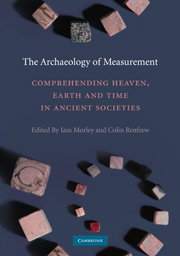Book contents
- Frontmatter
- Contents
- List of figures and tables
- List of contributors
- Acknowledgements
- The Archaeology of Measurement
- Introduction: Measure: Towards the construction of our world
- SECTION I NUMBER: COUNTING, MATHEMATICS AND MEASURE
- 1 Conceptualising quantification before settlement: Activities and issues underlying the conception and use of measurement
- 2 Measurement in navigation: Conceiving distance and time in the Neolithic
- 3 The token system of the ancient Near East: Its role in counting, writing, the economy and cognition
- 4 Grasping the concept of number: How did the sapient mind move beyond approximation?
- 5 Numerical cognition and the development of ‘zero’ in Mesoamerica
- 6 Recording measure(ment)s in the Inka khipu
- SECTION II MATERIALISING THE ECONOMY
- SECTION III DIMENSIONS AND BELIEF
- SECTION IV CALENDAR AND COSMOLOGY
- SECTION V THE SPIRITUALITY OF MEASURE
- Index
- References
2 - Measurement in navigation: Conceiving distance and time in the Neolithic
Published online by Cambridge University Press: 05 June 2012
- Frontmatter
- Contents
- List of figures and tables
- List of contributors
- Acknowledgements
- The Archaeology of Measurement
- Introduction: Measure: Towards the construction of our world
- SECTION I NUMBER: COUNTING, MATHEMATICS AND MEASURE
- 1 Conceptualising quantification before settlement: Activities and issues underlying the conception and use of measurement
- 2 Measurement in navigation: Conceiving distance and time in the Neolithic
- 3 The token system of the ancient Near East: Its role in counting, writing, the economy and cognition
- 4 Grasping the concept of number: How did the sapient mind move beyond approximation?
- 5 Numerical cognition and the development of ‘zero’ in Mesoamerica
- 6 Recording measure(ment)s in the Inka khipu
- SECTION II MATERIALISING THE ECONOMY
- SECTION III DIMENSIONS AND BELIEF
- SECTION IV CALENDAR AND COSMOLOGY
- SECTION V THE SPIRITUALITY OF MEASURE
- Index
- References
Summary
The conception and use of measurements are inherent within certain prehistoric activities. This chapter analyses the skills and knowledge needed for seafaring in the Neolithic and questions how distance and time may have been conceived and measured in relation to the land and seascape. Our modern notions of measurement dictate the development of science, technology and religion, which in turn guide our comprehension of the world. For example, the question as to who we are has been reduced to what we are and the quest to identify the smallest particles that can currently be measured. That of where we are becomes the study of the universe and the largest conceivable measurements. This in turn connects to concepts of time, the speed of light, the creation of time and of course, the end of it. These lines of thought lead us to cosmology and world-view. Whilst we are still striving to think about these things let alone understand them, how do we begin to investigate how people in prehistory constructed measurement to understand their world?
One place to start is with the physical archaeological correlates for measuring practices: written records and measuring devices, for example, weights or calendars (as discussed in other chapters in this volume). Yet, in earlier prehistoric periods and in contexts where these are not preserved, we can still detect the early incidence and understanding of quantification or measurement through consideration of the knowledge and skills that underpin various activities.
- Type
- Chapter
- Information
- The Archaeology of MeasurementComprehending Heaven, Earth and Time in Ancient Societies, pp. 19 - 26Publisher: Cambridge University PressPrint publication year: 2010
References
- 2
- Cited by



